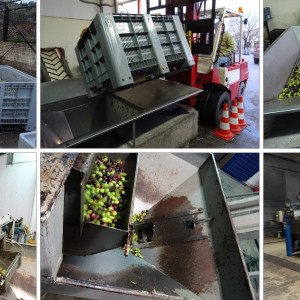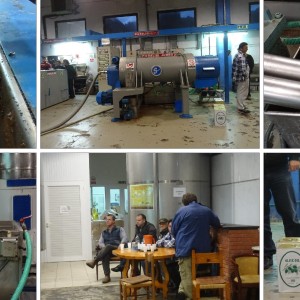Oil
I have been itching to show this to family and friends for twelve years, and finally here it is! The olive pressing process. I have made it in cartoon strip style to save on extras.
In the main pic we have the guy testing our oil for acidity, this is the most exciting part of the whole process – finding out exactly how good it is; ours came out at 0.3% which is excellent. There are people who prefer a higher acidity because they enjoy some bitterness, but generally most people like a nice low value.
Extras read left to right
- It's 5pm and we're ready to go. We have had our sacks of olives delivered to the factory and emptied them into these huge grey plastic crates. I have selected this shot to give a sense of scale. I think each crate must hold approximately 400kg of olives since we had just over 600kg and filled about a crate and a half.
- The forklift truck tips the crates into the hopper
- And that there is 609kg of olives in the hopper. The thing behind with the chevrons is the conveyor which lifts the olives up into the washer.
- Next you see the top of the conveyor inside the factory and the washer in front. The olives are tipped into a warm water bath and then run over a griddle to remove any twigs or leaves that may have been in the sacks. - - They end up in a stainless steel weighing basket.
- The weighing basket weighs the contents and then drops the olives into another hopper below, this one has an Archimedes screw not a conveyor belt and it lifts the olives into the mill itself.
- Bottom right image of the first extra shows the mill at high level, which empties the milled olives into a gutter which feeds one of four processing chambers. There are four rear chambers side by side and then another four in front. Each chamber contains a giant augur and can hold approximately 800kg olives. The olives spend about 30 minutes in the rear chamber and are then pushed through to the next chamber where they spend another 30 minutes or so.
- First picture in the second extra shows the olive pulp after is has been mashed around for an hour or so, just before it is pumped out to
- The centrifuge
- Which separates the oil from the water content of the olives. I am unsure about which part of the machinery removes the stones but they are removed and weighed separately.
- There are a couple more pieces of machinery who's purpose I haven't a clue about, we all joke that these are the chambers where the factory takes it 'cut' but it would be libellous to suggest that is really what happens, and out it pours, hot and golden.
- The factory therefore is processing eight harvests at any one time and the job takes about 90 minutes from start to finish and so they provide a table and chairs for customers to sit at and wait. This is moment in the sequence where the oil is tested for acidity and then finally
- It is pumped into the customer's own cans which are waiting on the scales.
We worked together with another couple, because none of us are getting any younger and it is hard work, together, their trees and ours, we harvested a total 609kg olives the processing of which cost 7 cents a kilo plus 13% VAT. Within that was 188kg of olive stones, the removal of which were charged at 2 cents per kilo plus 13% VAT. Our yield was 94kg which has therefore cost us 54 cents per kilo



Comments
Sign in or get an account to comment.


